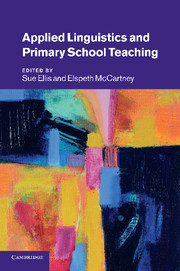Book contents
- Frontmatter
- Contents
- List of figures
- List of tables
- Notes on contributors
- Preface
- Editors' notes and conventions
- Introduction
- Part I Policy and diversity in the twenty-first-century primary school
- Part II The range and focus of applied linguistics research
- Part III Empowering teachers and teachers' use of knowledge
- Introduction to Part III
- 15 Building knowledge about language into a primary teacher education course
- 16 Using the International Phonetic Alphabet to support accurate phonics teaching
- 17 Developing word-level literacy skills in children with and without typical communication skills
- 18 The development of the Speech, Language and Communication Framework (SLCF)
- 19 How to empower teachers working with children with language impairments: why a ‘just-in-time’ model might work
- 20 Communication impairment in a multilingual context
- 21 Teacher education and applied linguistics: what needs to be understood about what, how and where beginning teachers learn
- References
- Index
19 - How to empower teachers working with children with language impairments: why a ‘just-in-time’ model might work
Published online by Cambridge University Press: 26 April 2011
- Frontmatter
- Contents
- List of figures
- List of tables
- Notes on contributors
- Preface
- Editors' notes and conventions
- Introduction
- Part I Policy and diversity in the twenty-first-century primary school
- Part II The range and focus of applied linguistics research
- Part III Empowering teachers and teachers' use of knowledge
- Introduction to Part III
- 15 Building knowledge about language into a primary teacher education course
- 16 Using the International Phonetic Alphabet to support accurate phonics teaching
- 17 Developing word-level literacy skills in children with and without typical communication skills
- 18 The development of the Speech, Language and Communication Framework (SLCF)
- 19 How to empower teachers working with children with language impairments: why a ‘just-in-time’ model might work
- 20 Communication impairment in a multilingual context
- 21 Teacher education and applied linguistics: what needs to be understood about what, how and where beginning teachers learn
- References
- Index
Summary
Introduction
Children who experience any form of language difficulty or delay are a highly vulnerable group in mainstream schools. Language difficulties can affect social and emotional development (Botting and Conti-Ramsden 2000) and academic achievement (Conti-Ramsden et al. 2009), including literacy achievement (Snowling et al. 2001), and they may result in lowered social self-esteem, at least until the end of compulsory schooling (Lindsay, Dockrell and Palikara 2010). Difficulties with language often impact on children's educational achievement because of the role played by expressive and receptive language skills in understanding oral and written language, and because of the importance of efficient phonological processing in learning to decode and encode writing.
Social inclusion policies in the UK, and in many other countries, mean that children with language difficulties are now spending most of their schooling in mainstream classes rather than in specialist language provision (DfEE 1998b; Scottish Executive 2002). These policies are premised on the belief that children who struggle with language will make best progress if they are immersed in the linguistically and socially rich learning environment of the classroom, and that the ‘dense and varied’ language experiences offered by the mainstream context will benefit such pupils.
There are large numbers of children with language, communication and/or speech difficulties, whether developmental difficulties or secondary to factors such as hearing loss or physical disability: ‘on average, every primary school classroom in the UK will have two or three children who have some form of speech language and communication needs (SLCN)’ (Lee 2008 : 7).
- Type
- Chapter
- Information
- Applied Linguistics and Primary School Teaching , pp. 252 - 266Publisher: Cambridge University PressPrint publication year: 2011
- 3
- Cited by

